
The National Archaeological Museum preserves a large number of exhibits of social and cultural history, which were discovered on Spanish soil and successfully preserved. Aware of the importance of history and its beauty, Queen Elizabeth II of Spain founded the Archaeological Museum on March 20, 1867. When it was founded, the museum was located on the Casino de la Reina estate. It was later moved to today's neoclassical building, whose architect was Francisco Hare. The museum building is also the building of the National Library of Spain. The building is very reminiscent of Roman buildings.
There is a very rich collection in this wide area, the diversity of which is enjoyed by all generations. The collection of objects in the museum begins from the period of prehistory to the Middle Ages.
Prehistory encompasses objects from the Early Iron Age to the romanticization of the country, so there are objects made of silver, gold, Islamic pottery, Phoenician, Iberian and Wake culture. Prehistoric jewelry, vessels, large sculptures and miniature objects. In addition, there are valuable objects and sculptures from the Roman Empire (I and II century), from Egypt, the Middle East and Greece. The collection from Egypt is so beautiful and rich that visitors often forget that they are in Spain.
The largest numismatic collection in the world is located in the Archaeological Museum in Madrid. Coins, paper money, money that has been used throughout history, not only in Spain, but all over the world. Inside the museum there is a rich library that offers an overview of historical documents and books. Visiting the library is possible only with an identity document, for foreigners only with a passport.
 Cena ulaznice za nacionalni arheološki muzej
Cena ulaznice za nacionalni arheološki muzej Radno vreme nacionalnog arheološkog muzeja
Radno vreme nacionalnog arheološkog muzeja